THIS is my favorite music career video because I learned some things too! Having never been in a recording studio, it's hard for my to explain all of the jobs related to the work. This is basic and clear AND interesting!
Wednesday, January 30, 2013
Tuesday, January 29, 2013
Terrific Tips for Tuesday - Keeping things Special
I am so happy that when my students come to my class they expect to sing and dance and play instruments. After all, we are musicians and we make music! Making music is beautiful and making music is FUN!
But even musicians have to get out pencil and paper sometimes and ya'll, I'm not lying when I say that I've had students cry about it.....Sooooo - I've gotten sneaky!
When a student asks me what we are going to do I always say a variation of this "Oh, today, is a SPECIAL day!, I've got something extra special planned just for you that I know you will enjoy". That way if we are singing and playing = Hurrah! If we aren't singing and playing for the entire class = Hurrah! They are happy and I'm happy and then I get out the SPECIAL supplies...... are you ready????
"Special" assignments:
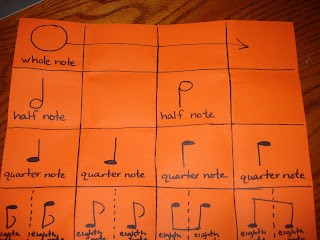 Not every written assignment is special....Only special assignments get special supplies. When I say "Special" assignments, I mean the ones that you need to do that are going to smell a whole lot like....dare I say it.... "school work"......(gasp!) I mean, the ones that might elicit grumbles of "Hey! This is Hard!" . I typically use the "Special" supplies when our activity is verging on "note taking".... When I ask my students to write out the notes and their duration, that is "SPECIAL". When I ask my students to write a reflection on yesterdays performance that is "SPECIAL". When I ask my students to create a vocabulary chart, or a fingering chart for recorder, those are both "SPECIAL". The assignments where I'm going to get to work with individual students who need some one on one time and where I may ask some students to be a buddy to another students..... Those are all "SPECIAL".
Not every written assignment is special....Only special assignments get special supplies. When I say "Special" assignments, I mean the ones that you need to do that are going to smell a whole lot like....dare I say it.... "school work"......(gasp!) I mean, the ones that might elicit grumbles of "Hey! This is Hard!" . I typically use the "Special" supplies when our activity is verging on "note taking".... When I ask my students to write out the notes and their duration, that is "SPECIAL". When I ask my students to write a reflection on yesterdays performance that is "SPECIAL". When I ask my students to create a vocabulary chart, or a fingering chart for recorder, those are both "SPECIAL". The assignments where I'm going to get to work with individual students who need some one on one time and where I may ask some students to be a buddy to another students..... Those are all "SPECIAL".
"Special" supplies: - It's amazing how much harder my reluctant learners will work when they feel special.
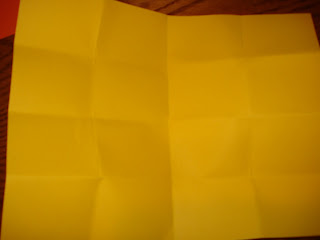
Special pens - I found some colorful pens at the dollar store and so I bought a couple of class sets. They work even better than the special paper, so if I have a particularly reluctant group, we may just use the special pens and call it happy. These work particularly well with older grades who may need to label their scores.
Special pencils - Mechanical pencils - I only buy these at the dollar store because they might not last the class, but I get nice neat work when I would have otherwise received scribble, so I'll take it.
Special effort is worth special regard - Music teachers don't have as much tangible written work to display as other teachers because most of our work is "you had to be there" work..... BUT, when we do give the time to our students to create a valuable paper product, we should display it. As you may remember from previous posts, last year my 4th grade recorder experience was consistently poor, I'd never had to work so hard to motivate children to play recorder in all of my life. One day as an act of desperate reteaching, I got out my "special" supplies and we create a recorder "cheat sheet". For once my class of unpleasantly frustrated students applied themselves and really worked. I stapled those "cheat sheets" up to my wall before class was even over because I wanted to communicate to my students that they had done well! They got it! They were so proud of themselves, they left puffed up like peacocks AND they finally learned those notes!
Ya'll have an awesome day!
But even musicians have to get out pencil and paper sometimes and ya'll, I'm not lying when I say that I've had students cry about it.....Sooooo - I've gotten sneaky!
When a student asks me what we are going to do I always say a variation of this "Oh, today, is a SPECIAL day!, I've got something extra special planned just for you that I know you will enjoy". That way if we are singing and playing = Hurrah! If we aren't singing and playing for the entire class = Hurrah! They are happy and I'm happy and then I get out the SPECIAL supplies...... are you ready????
"Special" assignments:
 Not every written assignment is special....Only special assignments get special supplies. When I say "Special" assignments, I mean the ones that you need to do that are going to smell a whole lot like....dare I say it.... "school work"......(gasp!) I mean, the ones that might elicit grumbles of "Hey! This is Hard!" . I typically use the "Special" supplies when our activity is verging on "note taking".... When I ask my students to write out the notes and their duration, that is "SPECIAL". When I ask my students to write a reflection on yesterdays performance that is "SPECIAL". When I ask my students to create a vocabulary chart, or a fingering chart for recorder, those are both "SPECIAL". The assignments where I'm going to get to work with individual students who need some one on one time and where I may ask some students to be a buddy to another students..... Those are all "SPECIAL".
Not every written assignment is special....Only special assignments get special supplies. When I say "Special" assignments, I mean the ones that you need to do that are going to smell a whole lot like....dare I say it.... "school work"......(gasp!) I mean, the ones that might elicit grumbles of "Hey! This is Hard!" . I typically use the "Special" supplies when our activity is verging on "note taking".... When I ask my students to write out the notes and their duration, that is "SPECIAL". When I ask my students to write a reflection on yesterdays performance that is "SPECIAL". When I ask my students to create a vocabulary chart, or a fingering chart for recorder, those are both "SPECIAL". The assignments where I'm going to get to work with individual students who need some one on one time and where I may ask some students to be a buddy to another students..... Those are all "SPECIAL". "Special" supplies: - It's amazing how much harder my reluctant learners will work when they feel special.

Special paper: - I use left over copy paper for "SPECIAL" assignments.In Houston we have humidity and humidity is the death of copy paper. Humidity is especially lethal to that last 10 pages from a ream of salmon paper used for a note home from the PTA. There are handfuls of left over colorful copy paper all around and because they aren't in reams they are very difficult to use in the copy machine without causing a jam. So that riotous rainbow of otherwise unusable copy paper becomes my opportunity to bless my students with something pretty. Ever now and then when I am running low, I'll buy a colorful ream, but I rarely need to, I just always make sure I have enough for 1 grade level to be "special" at any given time.
Special pens - I found some colorful pens at the dollar store and so I bought a couple of class sets. They work even better than the special paper, so if I have a particularly reluctant group, we may just use the special pens and call it happy. These work particularly well with older grades who may need to label their scores.
Special pencils - Mechanical pencils - I only buy these at the dollar store because they might not last the class, but I get nice neat work when I would have otherwise received scribble, so I'll take it.
Special effort is worth special regard - Music teachers don't have as much tangible written work to display as other teachers because most of our work is "you had to be there" work..... BUT, when we do give the time to our students to create a valuable paper product, we should display it. As you may remember from previous posts, last year my 4th grade recorder experience was consistently poor, I'd never had to work so hard to motivate children to play recorder in all of my life. One day as an act of desperate reteaching, I got out my "special" supplies and we create a recorder "cheat sheet". For once my class of unpleasantly frustrated students applied themselves and really worked. I stapled those "cheat sheets" up to my wall before class was even over because I wanted to communicate to my students that they had done well! They got it! They were so proud of themselves, they left puffed up like peacocks AND they finally learned those notes!
Ya'll have an awesome day!
Monday, January 28, 2013
Marvelous Mondays - Recorder fingering chart foldable
My favorite way to help students remember the notes they can play and read on recorder is to have students make their own "cheat sheet". Now ya'll know that a "cheat sheet" is nothing more than a student created fingering chart, but there is something powerful about facilitating an opportunity for students to write down for themselves what they know. This is particularly useful if you are trying to remind students about what has been taught either the semester or year before. My 4th and 5th graders are about to pick up their recorders again after a two month break, so this will be a good review and reteach.
 |
| We start with a plain piece of paper |
 |
| Fold it in half |
 |
| I always write on my paper in marker so that my students can see the work. Often I'll fold chart paper so that I can make mine bigger too. I ask my students to draw five parallel lines. |
 |
| Depending on the students and where they are, I may or may not ask them to draw a treble clef. |
 |
| Unlike the pictures here, I encourage and model keeping my paper folded up. Keeping the paper folded up while writing helps students focus on one note at a time. |
 |
| Depending on how far a particular class has progressed this may be as far as we get. |
 |
| The nice thing about drawing with pencils is that you can easily use both sides of the paper. |
 |
| Another option if you want to have room for middle (low C) is to double up a note as I do with F and F sharp |
Wednesday, January 23, 2013
Tuesday, January 22, 2013
Terrific Tips for Tuesday - Organizing papers
 |
| Inside each bin is an inclined file organizer. I got mine at King Dollar here in Houston! The best Dollar store EVER! |
Always a work in progress! - hope you find this helpful!
In 4th and 5th grade my students have folders. I use these folders for keeping track of recorder money and t-shirt money and permission slips and contracts and stuff and sometimes papers if we ran out of time to get out folders. It's a great place to keep things until they can be placed in student folders.
Friday, January 18, 2013
Funny Fridays! - Google Translate to the rescue!
Trying to teach without a voice is annoying and difficult. Trying to teach music without a voice is downright agonizing. After adjusting ALL of my lessons for minimal teacher vocalization this week AND after fighting for each word all week I decided today that I'd had enough. Because today I actually felt almost as bad as I sounded so I got a sub for the afternoon. The afternoon sub was a great idea, but I still had to get through my four morning classes......
What to do…. What to do……
That was when I remembered Google Translate. Because I had already considerably downsized my vocal output this week, it wasn't a big deal to type in the few things that I needed to say into the translator. I have an active board and speaker system hooked up to my computer so it was easy to adjust the volume so that everyone could hear and see what I was writing. I loved it because I can type almost as fast as I can speak, so I was able to answer questions with complete and thoughtful answers instead of limiting myself to nodding yes and no and writing on the board which takes longer. In kindergarten, after I motioned everyone to come in an sit down, which is part of our normal routine, I typed in "Everyone please stop talking". They were stunned into silence! I still had a couple of wanders who hadn't quite joined the class, so I simply pressed "play" again.... and again..... to which a student on the first row who was listening exclaimed..... "we heard you the first time!" I love kindergarten! It worked well with kindergarten because they couldn't read the words I was typing but they could hear them. It worked well with my older students because they could read along as I typed and they got a kick out of typing mistakes that would cause funny pronouncements. The majority of my students are bilingual they enjoyed watching the translations develop. Needless to say, computers still can't translate like we can. However, that was part of the fun.
I know you won’t be surprised by two things.
1. My ENT did give me some medicine, but he also reminded me that nothing takes the place of silence and water when dealing with vocal stress.
2. I will be using google translate much more as part of my arsenal of tools to decrease the amount of talking that I have to do.
Wednesday, January 16, 2013
Tuesday, January 15, 2013
Terrific Tips for Tuesday - Organizing crayons
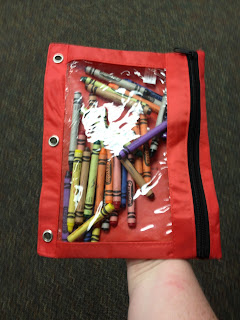 My grandmother was a teacher. She taught music. She taught art. She taught reading. She taught math, science and social studies. AND she taught me.
My grandmother was a teacher. She taught music. She taught art. She taught reading. She taught math, science and social studies. AND she taught me. I was in elementary school when she was invited to attend a professional development for art teachers using crayola crayons. She must have really enjoyed it because she spoke of that experience often throughout the rest of her life.
At this class she went to the very first thing they told her to do was to unwrap her entire set of crayons and break them into pieces. She loved "preaching" to me about crayons because as it turns out, I was and still am a little picky about my crayons. I still prefer my crayons nice and wrapped, but let go of my need to fuss with keeping a neat box....
Imagine my horror when I started teaching. I inherited an old mildewed corrugated cardboard box full of crayons some of which were probably as old as I was. When my students needed crayons for an activity, they just came and got a handful. UHHGGHH! I hated that box! For the next few years I tried various configurations of crayon organizations. I used baskets (with holes larger than the crayons they held).... I used school boxes (with lids that would flop open and spill all of the crayons back on the floor) and then one day I found a 3-ring zipper bag like I had in middle school in my notebook and I haven't used anything else since! Years later and I'm still happy with my bags. My favorite place to find them is at Dollar Tree stores I buy up all they have so that I can use these awesome bags to organize even more stuff!
I wouldn't recommend the ones with the plastic (heavy duty zip-lock) type sliders..... Those don't work. Vinyl pouches with real metal zippers work the best.
I find that when I need crayons out, it's usually with my younger students who are impatient and ready to get started. If I don't get those crayons out quickly then they will forget what I wanted them to do WITH the crayons......So I literally drop a bag and tell 5 kids to sit around the bag......I walk a few more spaces and drop another bag..... I can get all the crayons out and kids in groups in less than 3 minutes. THAT is GREAT when you are trying to keep your students on task.
I tell my students to dump their crayons on the floor because I've found that a "bag holder" = a "crayon hogger"......
When it's time to pack up, everyone picks up the crayons and zips the bag. I have a crayon bin and we are done! SOOOO EASY!
Monday, January 14, 2013
Marvelous Monday! - Rhythm + Math = Musical Math
FREE Download!
Musical Math
Hey Everybody!
This is a musical math worksheet that I made for my students. I hope that you enjoy it!
I have students add up these note values and then we put them on a number line.
Friday, January 11, 2013
Funny Fridays! - Pinky and the Brain
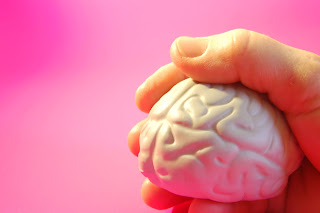
More than half my students are learning English as their second language. I would never consider my Spanish good enough to be called bilingual, but most of the time I can figure out what my students are talking about regardless of the language they are speaking in. Since they know that I almost understand them it is very common for students to forget that I am not entirely bilingual.... they just speak to me as if I am. My subject is one of the ones that is always taught in English, so as you can imagine I am constantly reminding my language developing students to practice their English.... Truly, music is the ideal place to practice because our song literature provides rich language that is both meaningful and plentiful.
I never know when my students are going to stumble upon a series of words that opens up a huge discussion about vocabulary. Rhyming words, homonyms and synonyms are most commonly the words that cause these occasionally comical discussions.
Whenever we have a word mix up moment, we pause and get out our pretend paper and write down our new word while I write them on the board. Then for the rest of the day when a new class comes in, someone will spot the words on my board and we'll end up having the same discussion all over again.
So today's word mix up didn't actually happen while we were singing, but as I was talking about the song.
In first grade we are singing "Ain't Gonna Let Nobody Turn Me Round". We had sung the song a few times and were about to start unearthing the details of the music when I paused to talk about the meaning. I said something like, "This song talks about the times in our lives when things are not easy. When things get hard in our lives we have to keep being brave........ (I was going to say something like........and keep moving toward our goal) when out of the blue, just after I said, "keep being brave...."
one of my young ones said, "I'm eating your BRAIN?"
The comment was so incredulous, sincerely confused and totally mystified that we just laughed and giggled and giggled and laughed.
Not brain! BRAVE!
Suddenly we were off having an unplanned but totally important about the words brain and brave.... especially to a second language learner, not only do they sound almost identical, but one is concrete while the other is abstract..... VERY challenging stuff for first grade. To undo the confusion we spelled our words and then we would switch back and forth between holding onto our brains and then making our "strong" arms.... The best part was that they didn't even realize that they were working hard because they thought it was so funny.
So fun!
Wednesday, January 9, 2013
MelodySoup Video Wednesday! - Week 2
Here is another great video about being an ensemble and studio musician. I like it especially because he speaks about being prepared and humble.
Tuesday, January 8, 2013
Terrific Tips for Tuesday! - Organizing pencils
So after 13.5 years of frustrating pencil management experiences I've finally come up with a plan that I have successfully maintained this year AND that is flexible enough for me to adjust according to the needs of my students and the time constraints we are dealing with on a given day.
1. I've got sooooo many pencils!
I can have up to 3 sets of (40) pencils in "active duty" at all times with at least that many in reserve in case we have a pencil emergency.
2. You pick two
I have my students either stay in their existing line from the door, or get in a line. The line of students faces the pencil station. The first person gets two pencils. They walk to the end of the line and hand off their second pencil to the person at the end. This works REALLY well for me. It might not work in every classroom set up, but it has turned out to be my preferred method of getting pencils out.
3. DRAWERS are awesome because they can't get lost!
When I kept my pencils in a box on a shelf, the box would wander off as we needed it, and then we spent time looking for the pencil box instead of using the pencil box. With these drawers, the "pencil box" is always ready to go! I have 3 sets of these drawers set up side by side. Each set is labeled with a different type of supply. As you see, I have a drawer labeled sharp # pencils and one labeled flat pencils.....These drawers don't work the way that I imagined they would primarily because my students and I don't have time to sort pencils as we clean up......SOOOOOO.....
2. Make the students do the work
As it turns out, sorting pencils that need to be sharpened, or are in need of erasers is a perfect act of community service for students that they can perform during class instead of doing the "fun" thing. I like the sorting job because it can be done without the pencil sharpener so it doesn't interfere with instruction.
3. Pencil sharpeners are evil!
I almost never allow myself or my students to sharpen pencils during class. I do it when I have to, but I never like it..... The sharpener is too loud. The sharpener is too expensive. The sharpener is too tricky. The sharpener is too tempting......Instead, if I have a student in need of a fresh pencil, they can visit the sharp # pencil drawer. Their pencil that needs attention goes in the flat pencil drawer and we move on.
4. It just takes 5...
At the end of class when my students are in line waiting for their teacher, during that small breath..... of time when one class is walking out and the other is waiting to enter I can usually snag a good helper to sharpen 5 pencils. Just 5.... that's all....They are done before the last person in line has even crossed the threshold and it's done. There are small snatches of time in all of our schedules when we find ourselves with 1-2 students in need of something to do....I almost always ask them to sharpen a few pencils for me. Even though I don't allow the pencil sharpener during class, I almost never have to sharpen pencils myself.
5. Drop it at the door!
I have a habit of raiding the Dollar Tree regularly to acquire my pencil bags because they are my favorite type of supply holder. I like them better than boxes because they can be dropped without complaint. I don't want to take up any more time picking up pencils than I do passing them out. So I keep a pencil bag on a hook by the door. When it's time to go, my pencil helper stands by the door and as students exit, their "ticket" is my pencil. Those "used" pencils now become the pencils that are sorted into sharp or flat drawers depending on their condition.
6. Pencils are a privilege!
I can read crayon as easily as I can read pencil. If I notice any misuse of the music classroom pencils then that student can write with a crayon.
Monday, January 7, 2013
Marvelous Mondays - Music Vocabulary Foldable
Here is a vocabulary activity my 2nd graders did this fall that they were very excited about.
At the time we did this activity my 2nd graders had internalized enough of these words that before this activity, everyone in the 2nd could easily demonstrate and identify loud, soft, fast and slow, and when presented with dynamic words they could work together to puzzle out definitions, but only a few were using the dynamic words in context. So I knew we had LOTS of room for growth. I wanted everyone to use those words and I wanted to add some new words to deepen our understanding of dynamics while introducing new words for tempo.
1. We folded our paper in half 4 times
2. Then we listed headings: loud words, soft words, fast words, slow words
3. We talked about the words we knew
4. As we came up with the dynamic words we knew, we would add them to our list
5. When we got to crescendo / decrescendo I wrote the symbols on the board, we developed our definition and then we learned the word.
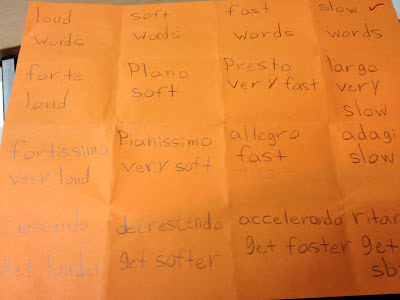
6. Then we watched this quick video to remind ourselves of how each word sounds. I debated with myself about using a variety of listening selections, one for each word, but I think that would have been too much too soon in this case.
I think maybe because 2nd graders still very eager to learn and because they are learning so quickly, my students were not just thrilled with the video and what they knew, but they were begging me to tell them what words should go in the other blanks.
7. I explained that although they had heard me use these words, seen them on my walls, and even listened to music that could be described with these words, all of these words were new.
8. Then we very carefully built the other side of the chart. We started with allegro and adagio. By the end, they had ALL filled in every square. I've never had such young students work so persistently at a "note taking" activity before.
When they finished, we watched:
They loved it! AND even more important, I have noticed a nice increase in the use of music vocabulary words.
Friday, January 4, 2013
January YUMMY Award - Over the Rainbow
January 2013
"Over the Rainbow" Author: E.Y. Harburg, Illustrator: Eric Puybaret, Performer:
Judy Collins, Composer: Harold Arlen
This book is just lovely! The opening verse of the song is one that most haven't heard before and it makes the song that we all know and love even more special. Judy Collins goes on to sing and "I See the Moon" and "White Choral Bells".
I plan on having my choir sing "Over the Rainbow" this spring and look forward to sharing this book with them as part of their introduction to the song.
Wednesday, January 2, 2013
Melodysoup Video Wednesday!
Here is the first video in a series of Music Career videos. Musical career information for older elementary students is tricky to find. This is a great video that I look forward to using with my 5th graders this spring. I hope you enjoy it! This video is about Music Therapy.
Subscribe to:
Comments (Atom)























